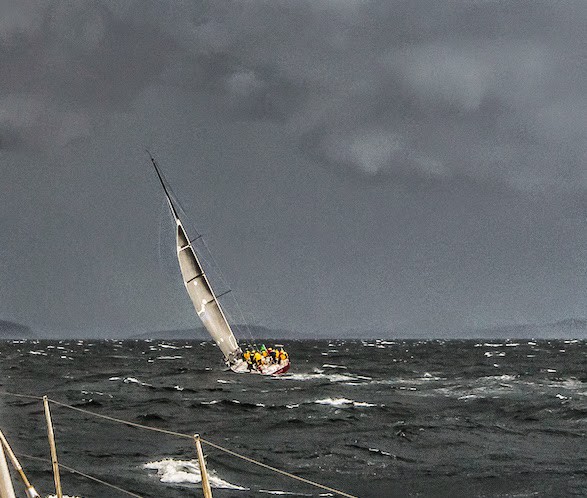Sailing: Sydney to Hobart 2014
The Sydney to Hobart Yacht Race (official site, wikipedia) is an Australian yacht race that goes 630 nautical miles from (unsurprisingly) Sydney, NSW to Hobart, Tasmania. It’s part of the CYCA’s Blue Water points series. Growing up in Australia, it’s a big event — most Australian’s have heard of it, and many people watch the start on Boxing day each year. It has a bit of a reputation — the Bass Strait can be a tricky stretch of water, and it’s a long race — earlier generations of boats would take 4–5 days to get there.
Last year, not long after getting my Yachtmaster, I was invited to help deliver the boat (a 52 foot Judel/Vrolijk) back from Hobart. At that stage, I figured it was a good way to get some miles and had no plans of doing the race. Also, it seemed like a good introduction to what to expect. With 80 knots of wind and 30 metre swell, it turned out to be a lot more than just an introduction, more of a trial by fire! Anyway, when the invite came this year to do the actual race, I quickly said yes.
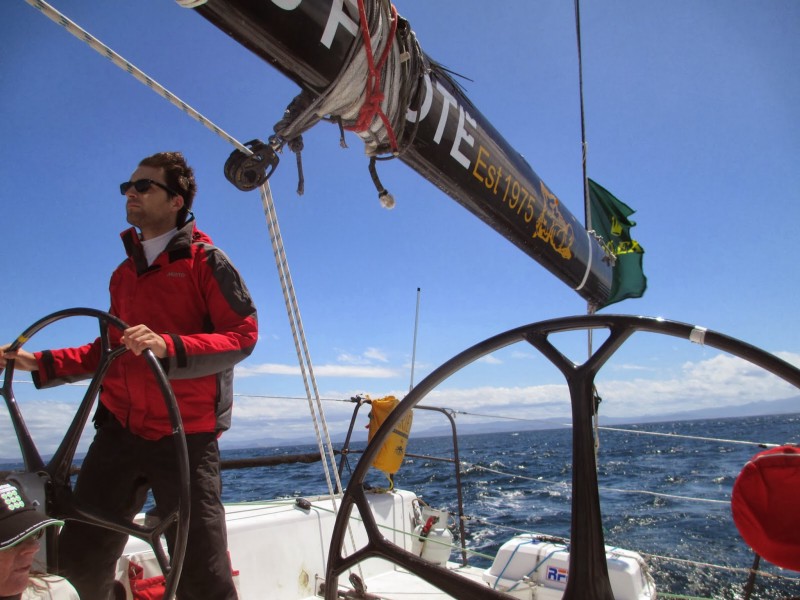
This year, we left Sydney with what I thought was an excellent forecast for my first Hobart — a strong southerly at the start, followed by a light northerly almost all of the way to Hobart with the possibility of a bit of a westerly at the Derwent River. My theory was that there’s always going to be a southerly come through at some point in the race, I’d rather it near home than in the middle of the Strait. And an exciting finish sounded.. well.. exciting too. The media had the opposite analysis with a very doom and gloom (and sensationalised) prediction.
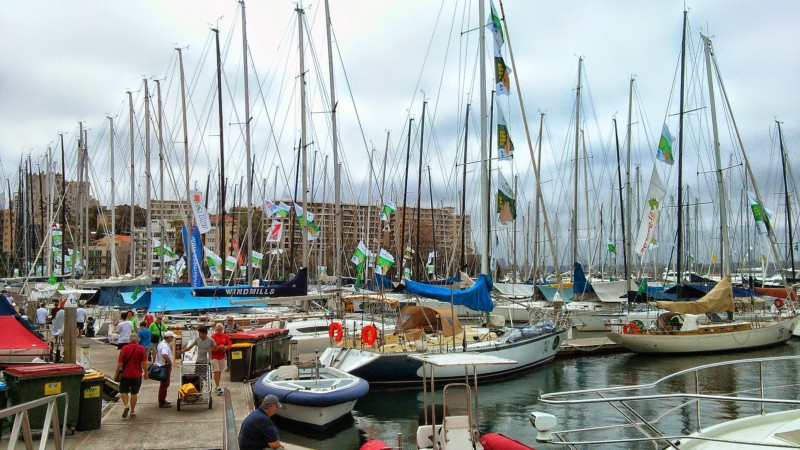
The reality turned out pretty close to the forecast. The start was incredible — 117 boats all crossing two start lines and leaving the harbour at the same time. It’s like the start on a Saturday race times ten. There were helicopters everywhere pulling crazy stunts like flying between boats below mast level. It’s pretty exciting starting a race with all the 100-foot maxis, too. There was plenty of breeze, so we crossed the start line doing about 10–12 knots, in a group of about 6 boats all beam to beam and lots of yelling (and a lot of questionable interpretations of the windward/leeward rule).
Once we were out the heads, it got pretty bumpy. Then it got really bumpy. I made the amateur mistake of not getting my full wet weather gear on — it was a hot day and I’d been crazy busy from 8am until we crossed the start line. I figured it was a hot day and the spray would dry before I got cold. Wrong, wrong wrong, and I should (and did) know better. We put a reef in a few hours later, and then just about when it started getting dark, predictably for me, I got sea sick.
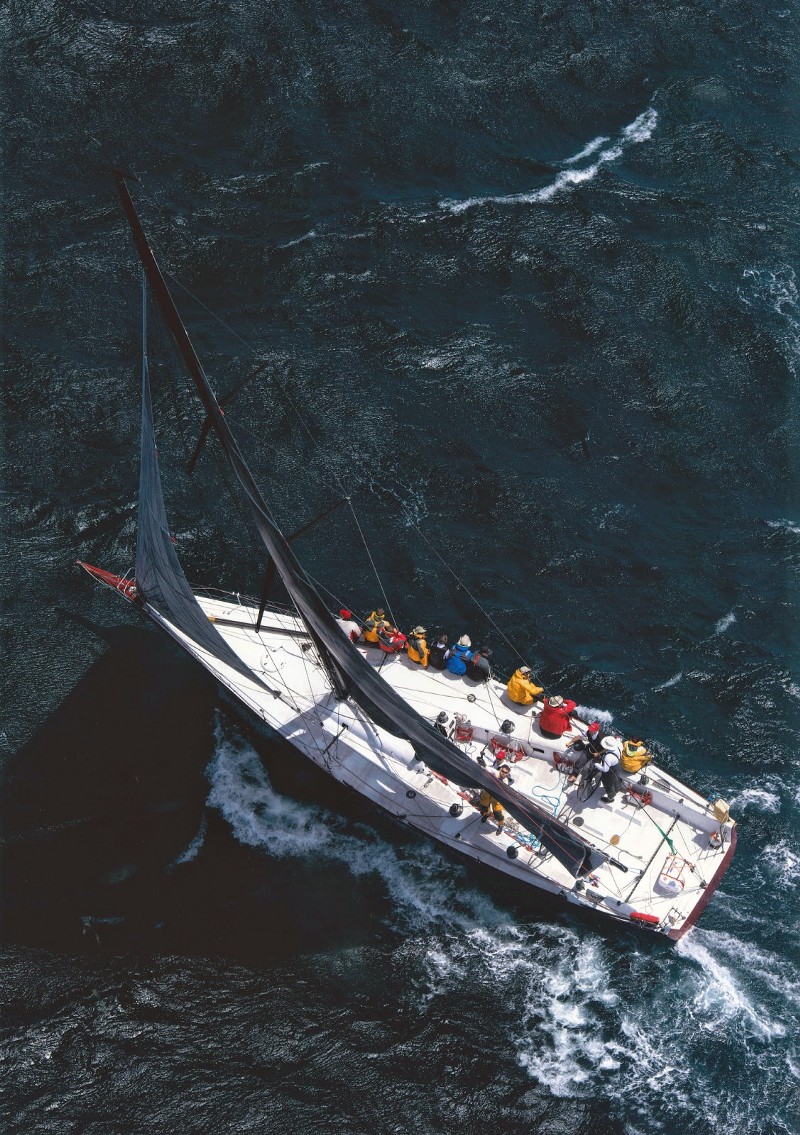
Reef going in. That’s me in the red hat next to the boom.I’d been to the GP a few weeks earlier to try and get the best possible medication. Stemetil was the recommendation, and it definitely seemed to work on a trip to Kangaroo Island I did a couple of weeks earlier. But it wasn’t enough. Being cold, wet, and sick, I was in a bad way. I ended up having to go below and lie down for a bit. I did take top windward bunk so I was at least using my weight for good purpose, but this did not help me earn the respect of the rest of the crew who spent almost the entire night sitting on the rail. My attempts (and diagrams) in Hobart to explain how my weight on the bunk was actually providing almost exactly the same righting moment didn’t help…
While it might have been drier and flat (in the X axis at least) in the bunk, it was still an (uncomfortably) exciting ride. The boat launched off a few big waves, and at least once got completely airborne. The brief second of floating above my bunk was an experience I wont forget. There’s an incredible thudder (like a thud and a shudder) that the boat makes when it lands where you think the whole rig is going to come down and the boat’s going to rip itself to bits, but as you know, boats are built of tougher stuff than I am.
After about 6–8 hours, on skippers orders, I was requested to fix the electronics, which also hadn’t fared so well in the rough stuff. Fortunately it all came back to life, with the one exception of my homemade GPS display which hadn’t survived the above-deck swimming pool (more on that in a later post).
Then the wind dropped out and we were left with a northerly, which we rode under spinnaker for the next 36 hours. That doesn’t mean we were cruising though as the helmsman uses every wave to accelerate the boat, bringing the apparent forward, requiring constant spinnaker trim. So trim on, off, on, off, etc. My tiny little arms got quite the work out on the grinder. We also did several spinnaker changes, and a few almost-broaches, destroyed two kites, repaired one (sewing practice!), then destroyed another. At one point we were about 100 miles offshore, and there was some brief speculation that we were possibly the most easterly boat of the fleet (later confirmed to be not true).
At some stage, the wind dropped out completely, but for the most part we held about 20 knots of true as square as we could hold the asymmetric kite, and about 12–15 knots of boat speed. Sadly without the GPS I’m not sure how much I trust those numbers though. On this particular boat, 13 knots is about the speed where the hull/keel starts humming. Early in the spinnaker run, the vang snapped off its attachment at the base of the mast, which resulted in a fun bit of improvised engineering (always my favourite part of sailing) but unfortunately left us without a quick way to adjust vang tension, so we had to run a lot more conservatively. Right at the end we also poled out a headsail, I think the number 1 heavy, which led to the depressing realization that it was almost as fast as the kite.
After a gybe back in towards Hobart, one of the crew members uttered “I thought this was supposed to be a tough race” and a couple of hours later the weather granted him his wish. Very quickly we were in 40 to 50 knots of south-westerly. The main ripped (fortunately below the second reefing point), so with two reefs in the main and the number four, we bashed down past Storm Bay and into the Derwent River. After a couple of switches backwards and forwards between the storm jib and the number four, the luff track for the main ripped off the mast, so we went for a trysail. Needless to say, it was chaos on deck, but we successfully crossed the line (including an excellently handled lift just at the right time at the end to clear the pin) with the storm gear up. Finishing time was three days and three hours, a record for the boat.
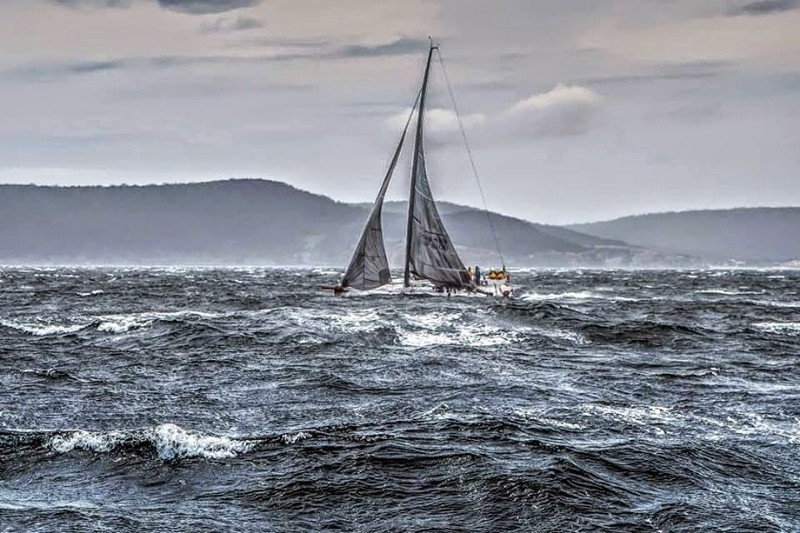
We were 39th across the line, which put is 4th in our division (PHS Div 1). It’s frustrating to think that if we’d just averaged about a quarter of a knot faster through the spinnaker run (and with a vang that might have been a possibility) or dealt slightly better with the strong winds at the end then we could have done a lot better. But that’s the nature of sailing! Plus we got to see a whale, dolphins (so many dolphins) and a pack of seals. Arf!
Pulling in to Constitution Dock was an incredible feeling. It was 4pm, so loads of people around, plus a hive of activity with all the boats. They hand you a slab of Cascade as you arrive at the berth, then the crew race to get the boat cleaned up before heading to Customs House.
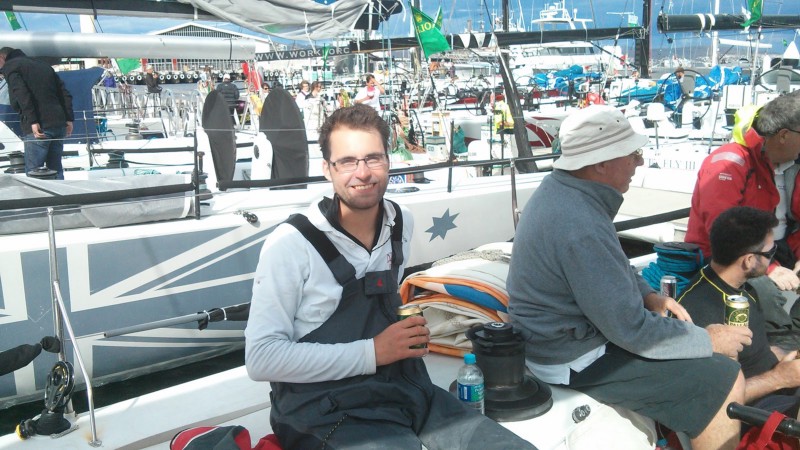
So, what was the hardest thing about this race? Perhaps surprisingly, not the sailing, but the social dynamics. 15 people on a boat for three days, sleep deprived and both physically and mentally exhausted, and in a very confined space. That really does your head in. The sailing was for the most part very similar to what we deal with on the harbour races, but the benefit of having a lot more space to execute a manoeuvre. It’s fascinating to watch the crew members who have done it many times before because they’ve figured out the routine and the little things that make everything easier. For one of the crew members, Tony, this was his 49th Sydney to Hobart — he’s currently the record holder.
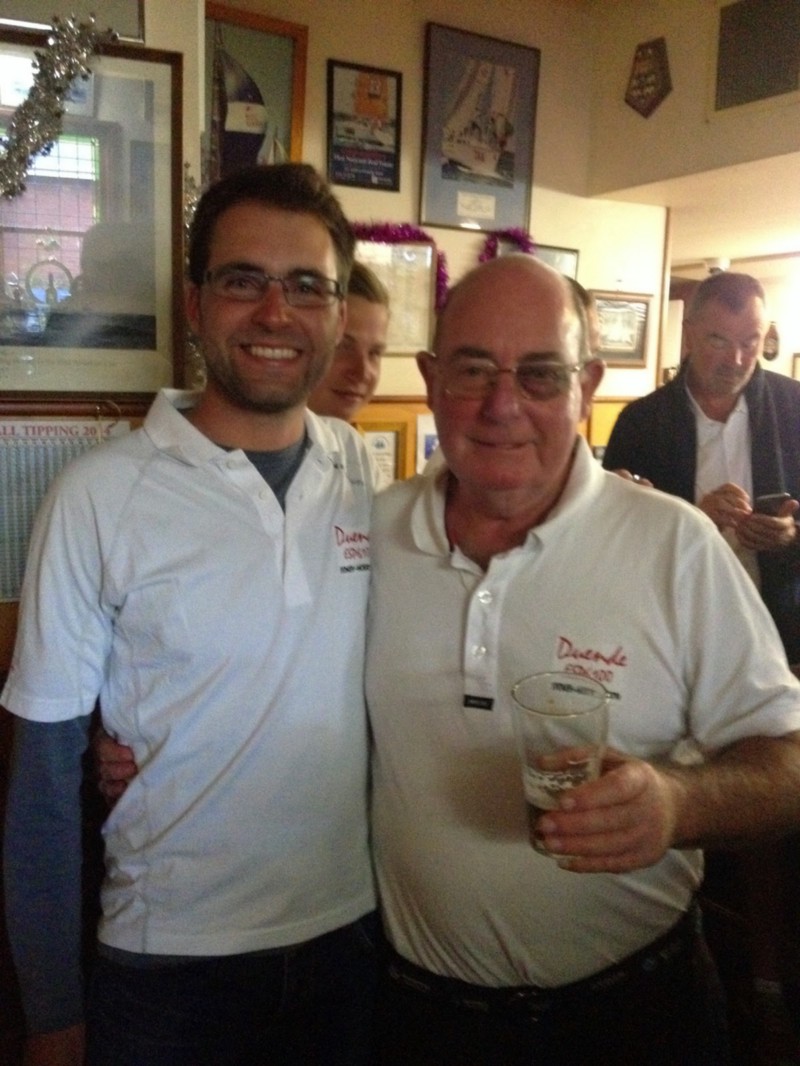
One of the highlights, surprisingly, was the food. Huge shout-out to Matt who did all the cooking beforehand with 3 days worth of prepared food in foil trays. Basically just like airplane food, but that’s a huge disservice to how good they were. We had roast turkey, paella, sausages, eggs, bacon, satay chicken, etc. When you’re cold, tired and hungry, good food is the best thing ever.
I stayed in Hobart for several more days, visited the Taste of Tasmania food festival several times, spent a bunch of time at Custom’s House and the Shipwrights Arms, and went to Mona. Mona was… interesting, but by far the highlight of that trip was meeting the boat manager of Wild Oats XI on the ferry on the way back and getting invited for a tour of Wild Oats. He opened every single compartment and explained every possible aspect of the boat, super interesting stuff.
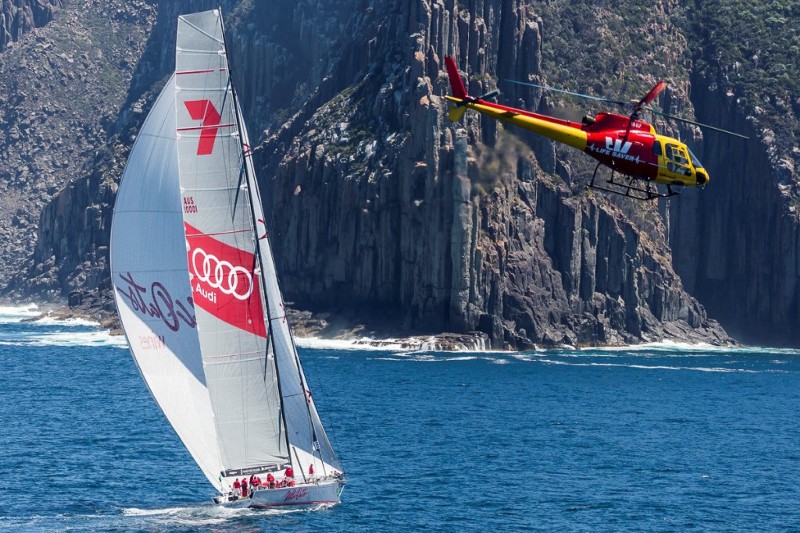
Speaking of Wild Oats, there were five 100-foot maxis in the race this year. Comanche, Rio 100, Ragamuffin, Loyal, Wild Oats XI. Sadly, Loyal had to abandon after suffering hull de-lamination. We actually passed them on their way back — it was exciting for a while as we thought we were gaining on another boat, but when we realized their sails were set for upwind it was obvious what was going on. The media were obsessed about Comanche, and for obvious reasons, it’s an incredible boat. But the rest of the boats don’t feel the same love for the maxis, because they take a lot of the attention away and also they race a entirely different race — they see a completely different weather system. It was hilarious to see all the crowds walking around the dock asking where Comanche was, and see the various signs that boats put up.
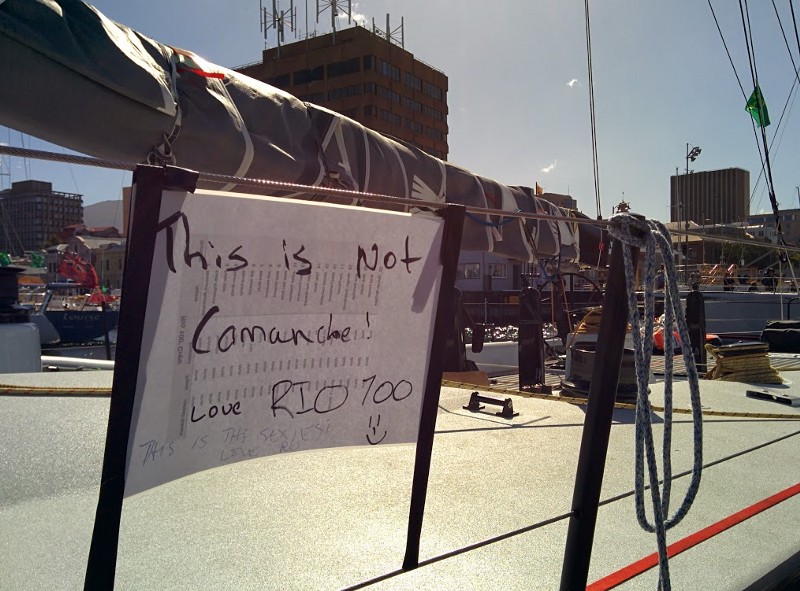
Some tips for anyone who might be considering doing the race:
- Wet weather gear is really important. My Musto BR1 trowsers and BR2 jacket were only just up to it. The cheapo Burke boots did fine, but only thanks to the velcro that Eddy helped me attach.
- Despite being summer, it can get quite cold at night. The usual advice — base layer, mid layer, outer. Also, I have these fantastic waterproof socks from Sealskinz. Also, Hobart is surprisingly cold in the night time; bring a sleeping bag, because the last thing you want to do is sleep in your sailing gear when you get there.
- Relatively few people on the crew had Leathermans (or similar). Mine got a total workout.
- Don’t do it as your first big ocean race (or voyage). I was so glad to have done the delivery in the opposite direction, plus a Southport and a Cabbage Tree. Just little things like how to live effectively out of one tiny bag and knowing that you have to get your gear on before the race starts (hah..).
- Make sure you know the crew well. When everyone’s a bit stressed, it’s very helpful that you’re friends. Plus they’re likely to be more forgiving when you go AWOL for a few hours.
- Similarly, make sure you know the boat back to front. In an emergency, you need to be able to find stuff quickly, and know the boat’s way of doing things.
- Read both these books: The Proving Ground and The Fatal Storm. They’re both about the tragic events of the 1998 race where five yachts sank and six sailors died. The books, while quite different, are both excellent and really do an incredible job of describing some of the details of the race. More importantly, they have some really solid advice on safety and lessons learnt.
- Get a good head torch. Make sure it remembers that night mode (red light) was on. I have a LED Lenser SEO3 and it is perfect.
- Prepare the boat early. It always takes longer than expected and you don’t want to spend Christmas Eve, Christmas Day and Boxing Day morning doing repairs.
Overall, an incredible experience that I won’t forget. I’m unbelievably grateful to our skipper Damien, navigator Donald and the rest of the crew for this opportunity.
